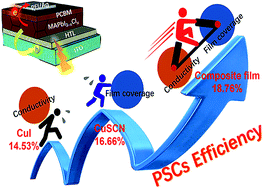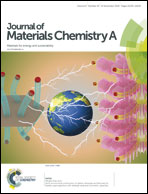One plus one greater than two: high-performance inverted planar perovskite solar cells based on a composite CuI/CuSCN hole-transporting layer†
Abstract
The low-cost and stable inorganic p-type semiconductor copper(I) iodide (CuI) is a promising hole-transporting layer (HTL) material for inverted planar perovskite solar cells (PSCs). However, the power conversion efficiencies (PCEs) of inverted planar PSCs based on CuI HTLs reported so far are not satisfactory and far behind those of their organic counterparts. Herein, we demonstrate a simple but effective approach to improve the performance of inverted planar PSCs based on the CuI HTL through the incorporation of copper thiocyanate (CuSCN) into the CuI HTL. As compared to pristine CuI, the introduction of CuSCN significantly improves the quality of the film, resulting in a smooth and uniform film while maintaining relatively high electrical conductivity. As a consequence, the champion device based on the composite CuI/CuSCN HTL affords an impressive PCE of 18.76% under full sun illumination (100 mW cm−2, AM 1.5G), which is substantially higher than the corresponding values of the respective devices containing pristine CuI (14.53%) and CuSCN (16.66%). This value is one of the highest efficiencies reported thus far for CuI- and CuSCN-based HTLs in PSCs. This work demonstrates the great potential of low-temperature solution-processed CuI/CuSCN composites as hole-selective layers for low-cost and efficient PSCs as well as other optoelectronic devices.



 Please wait while we load your content...
Please wait while we load your content...